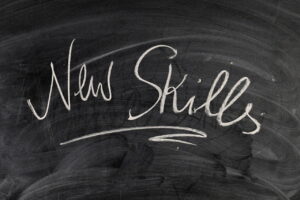
From New Math To Sight Words: Here’s What Kids Are Learning In School Now
Across the country, parents are discovering that what their children bring home from school looks very little like what they once learned. It isn’t just math — reading lessons, writing expectations, even how science and history are taught have shifted. What once relied heavily on memorization has given way to conceptual thinking, inquiry and skills tied to the future workplace.
Educators say these changes are not random or trendy. They’re the product of research, shifts in workforce demands and national policy decisions that have reshaped the classroom over the last few decades. But for parents, the changes often arrive without much explanation, leaving them feeling lost.
To understand why classrooms look so different today, it helps to trace how teaching methods have evolved. From the rise of “new math” to the renewed focus on phonics, the story of modern education is one of pendulum swings, policy mandates and, above all, an ongoing debate about how kids learn best.
From Memorization To Meaning
“Some of the major changes in teaching practices are a direct result of the standards and now Common Core, with a shift from rote memorization to conceptual thinking and problem-solving,” Yolanda Carlos, an early childhood education professor at Pacific Oaks College, said.
Where students once filled in worksheets with multiplication tables or copied definitions from a chalkboard, today’s lessons aim for depth. Teachers want students to make connections between ideas, explain their reasoning and apply skills to real-world scenarios.
Michaela LeRoy, education and development specialist at the Haven Collection, a comprehensive family care center, described it as: “Twenty to 30 years ago, subjects like reading, writing and science were often taught through textbooks and rote memorization. Today, subjects are more integrated and inquiry-based, encouraging students to ask questions, investigate and apply concepts to real-world situations.”
This doesn’t mean facts have disappeared. Kids still memorize math facts and spelling patterns. But the goal is less about storing knowledge and more about understanding why it works, a skill researchers say better prepares students for a rapidly changing economy.

Why ‘New Math’ Sparks Old Frustrations
If one subject embodies the clash between old and new, it’s math. The phrase “new math” has become shorthand for parental exasperation.
“Parents can become uncomfortable with changes they do not understand and therefore feel they cannot support their child’s required learning activities,” Carlos said. “Most parents’ understanding of mathematics is based on recalling facts, procedures and formulas. Today’s math requires thinking, reasoning, collaboration and problem-solving, the very skills employers want in the workforce.”
To many parents, breaking apart numbers, drawing arrays, or showing multiple solution methods feels unnecessary. But teachers argue it helps kids develop number sense and flexibility, making them better problem-solvers long term.
Dr. Geillan Aly, a math educator and researcher at CUNY, calls this recurring debate “the cycle of benign neglect”: “Every few decades, we swing from procedural to conceptual math learning. But parents and teachers are often left without enough support, creating frustration and what I call ‘math trauma.’”
And that trauma is real. A parent who struggled with math in school may feel defeated when they can’t help their child. A child sensing that frustration may internalize it. And soon, math becomes a source of tension rather than growth, Aly adds.
Phonics vs. Sight Words — The ‘New Math’ Debate For The Humanities
Math isn’t the only battleground. Reading instruction has seen its own pendulum swings.
For much of the late 20th century, schools leaned on whole language and sight word memorization, encouraging children to recognize words by sight and read through context. Critics argued that this left struggling readers behind, unable to decode new words.
The pendulum has swung back toward phonics, or explicit instruction in letter-sound relationships. But most researchers agree the answer isn’t either/or, it’s both.
“Reading is not innate,” Carlos said. “The science of reading shows a strong correlation between word recognition and language comprehension. Good readers have both decoding skills and strong word recognition.”
“Research undeniably shows that systematic phonics instruction is the most effective for the majority of kids,” Beth Gaskill, an educator, learning specialist and the founder of Big City Readers, told HuffPost. “Sight word lists gave them a handful of memorized answers. Phonics gives them the key to unlock every word.”
And Zack Barnes, a literacy professor at Austin Peay State University, explained that this “science of reading” movement has influenced policy in dozens of states. Many now require screenings for dyslexia, additional teacher training and curricula that emphasize phonics while also supporting comprehension.
The Policy Legacies Of ‘No Child Left Behind’ And Common Core
If there’s one federal policy that parents and teachers alike remember most vividly, it’s No Child Left Behind (NCLB). Signed into law in 2001 under President George W. Bush, the sweeping legislation reshaped the fabric of American education almost overnight.
Its premise was straightforward: hold schools accountable for student achievement, with the promise that every child — regardless of ZIP code, race or socioeconomic status — would receive a “high-quality education.”
The way it measured that promise, however, was through standardized testing. Annual assessments in reading and math for students in grades three through eight, plus once in high school, became the yardstick by which schools were judged. Funding and even school survival were tied to performance. Schools that failed to make “adequate yearly progress” (AYP) faced escalating consequences, from mandated tutoring to state takeovers.
For policymakers, the law was about equity, closing the achievement gap and ensuring transparency. Classrooms increasingly revolved around test prep. Curriculum narrowed as subjects like art, social studies and even science were sidelined in favor of boosting reading and math scores.
“Teachers were teaching kids how to pass a test, not how to think.”
– Sarah Seitz, founder of The Enrichery tutoring center
“Teachers moved toward graphic organizers, project-based learning and a heavy reliance on technology, not always because it was best practice but because it was the most efficient way to hit testing goals,” Carlos said.
Sarah Seitz, founder of The Enrichery tutoring center, described how the legislation made classrooms test-driven. “Creative subjects were squeezed out aside,” she said. “Teachers were teaching kids how to pass a test, not how to think.”
And yet, some positive legacies remained. LeRoy said one of the law’s most enduring shifts was how data was reported. For the first time, schools had to break down performance by subgroup — by race, by disability, by English learner status. That meant you couldn’t just hide behind an average anymore. Every child counted.
Still, the tradeoffs were hard to ignore. Barnes said the over-testing was real, but so was the insight: “I think NCLB ushered in a reliance on over-testing our students, but also allowed us to dive into the data to figure out where schools and states were doing poorly.”
By the late 2000s, bipartisan consensus had emerged: the law’s intentions were noble, but its implementation was deeply flawed. That realization eventually paved the way for its replacement in 2015 with the Every Student Succeeds Act (ESSA), which gave states more flexibility and attempted to balance accountability with a broader view of what student success could look like.
How Parents Can Help Without Losing Their Minds
So where does this leave parents trying to support their kids?
Carlos suggests parents focus less on mastering the new methods and more on modeling curiosity: “Read to your children, model reading yourself and set aside a quiet study space. Take them to the library, have regular conversations and limit device time. Small daily habits make a big difference.”
Seitz cautioned against undermining teachers: “One of the biggest mistakes is saying, ‘This is how I learned it. Let me show you a better way.’ Kids hate that. The best thing you can do is ask your child to walk you through their method. When parents mirror the teacher’s approach, kids gain confidence and homework fights drop dramatically.”
Jamie Hendrickson, principal at the Meyer Levin Middle School for the Performing Arts in Brooklyn, New York, echoed the importance of partnership: “Review the curriculum, attend Curriculum Night and use resources like Khan Academy. Partnering with schools turns confusion into collaboration.”
Education Will Keep Evolving
If today’s classrooms already feel foreign, tomorrow’s may feel even more so. Experts predict that artificial intelligence will act as a personalized tutor, adjusting lessons in real time. Competency-based education could replace letter grades, with students advancing as they master skills. Social-emotional learning may be woven into daily lessons, teaching resilience, teamwork and empathy, while global collaboration may become routine, with students working virtually with peers across the world.
“Parents may be surprised to see less rote work and more whole-child, brain-based learning,” said Gaskill. “Social-emotional skills will sit side by side with reading and math.”
For parents, that may mean the kitchen-table homework battles of the future won’t be about long division at all, but about how to ask the kinds of questions that no textbook yet has the answers to.
“With AI everywhere, kids won’t be judged on how many answers they know,” Seitz said. “They’ll be judged on how well they can frame the right questions.”
Source link



